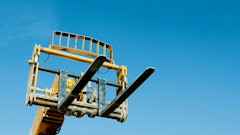
In April this year, I had a business trip to Fargo, N.D., to RDO Equipment’s field support office for some meetings.
The week before I left, I checked the weather forecast, and was happy to see some pleasant spring temperatures expected during my visit. I figured I might sneak in a round of golf if I had time before my return flight.
I packed my bag accordingly several days later, and I didn’t check the forecast again in the meantime, so you can image my surprise when I was greeted upon landing by a late spring snowstorm. So much for that round of golf.
The economy is a little like that right now. You can look at certain indicators but knowing really where things are heading, even as soon as next week, feels a bit like a fools’ errand – or maybe a golfer’s error, in my case.
There are many variables in the air right now, and if you’ve been involved in the construction industry, or kept even remotely up-to-speed with current events, they won’t be new to you here.
On one hand, increasing housing starts and the infrastructure bill that passed earlier this year are both promising indicators of future work. On the other hand, inflation is up, the supply chain is still slow, and no one can find enough labor.
If you are a contractor trying to figure out what kind of equipment to buy, the fact that it’s hard to tell if this storm is coming or going isn’t making anything easier for you.
But whether the clouds are gathering ahead of us or receding behind us, there are plenty of considerations to make and questions to ask to make the best decisions for your business.
1. Order Way Ahead, Carefully
In terms of timeline, buying new equipment may be one of the toughest scenarios to predict right now. Given the challenges I listed above, it’s tough to say with certainty how much a new machine will cost or even when you’ll receive it.
Some dealers won’t even accept orders of certain machines right now, there’s just too many unknowns. So, what can you do?
First, think ahead. If you know you’re going to need that machine, start looking into it sooner rather than later.
Talk to your dealer, and before you move forward with any deals, make sure you read all the fine print. Get as much information as you can about maximum delivery dates and prices.
If you can’t get a price-protect guarantee on a machine, make sure you have an exit clause of some kind factored into your deal. Don’t allow yourself to get caught out in the rain tomorrow because of today’s unknown variables.
2. Consider the Right Level of Used Equipment
Buying used equipment can be a great option for many reasons, even in the best of times. Today, it’s a more popular route than ever before, partially out of necessity, but also because it’s smart–if you know what to look for.
My experience tells me if a used machine fits the needs of your backlog, and you can find a new- or late-model one still within the first 40% of its operating life, you should buy it.
The supply/demand and inflation variables are always going to be just that–variable. But while used equipment prices have been surging, we know that they’re naturally going to depreciate quicker as the supply chain starts heading back toward normal, whenever that may be. Anything past that 40% mark could end up costing you more in repairs and downtime than it’s truly worth. That brings me to my next point.
3. Prioritize Preventative Maintenance
Regular maintenance of your fleet is always crucial for maximizing your uptime. Now, as we’re looking at unpredictable equipment availability and extended delivery times, keeping your current fleet in good condition is more important than ever.
Tap into your relationship with your dealer to help develop a maintenance schedule that both parties can stick to. Remember, all the aforementioned variables are affecting not just equipment cost and availability but parts and labor, too.
Make sure you have a partner who can commit to serving your fleet in a way that fits your business. If you don’t know, check into your dealer’s strategy on sourcing parts.
Make sure they’re equipped to have the parts in-stock that you’re likely going to need in the not-too-distant future, or that they’ve got the resources to get them to you quickly in a pinch.
4. Keep Your Eye on the Clouds
I’ve talked about all the variability at play here, and that’s going to remain an ironic constant. But there are a few key indicators to watch to give you the best forecast.
Mortgage rates impact housing starts, and housing starts are vital to the construction industry. These two indicators, still promising at the time of this writing, will preview where things are heading at-large.
Elsewhere in the industry, note oil prices. At the time of this writing, the price per barrel hasn’t hit a point to trigger a flurry of activity in the oil fields, but if that does happen, the resulting upswing for the construction industry will quickly follow.
As we look at the next year or so for the construction industry, there’s a lot to be excited about, but that excitement is going to come with some anxiety, too. Plan ahead, do your research, and leverage your relationship with your dealership to weather the storm as best you can, regardless of which direction it’s heading.
Returning to my analogy from earlier, make sure you aren’t left with a tee-time in an April snowstorm. No need to take up valuable luggage space with golf shoes when the weather calls for snow boots.





























